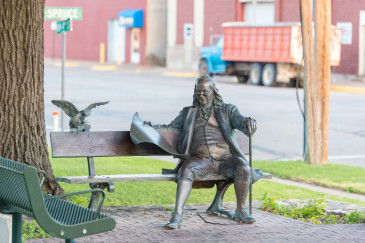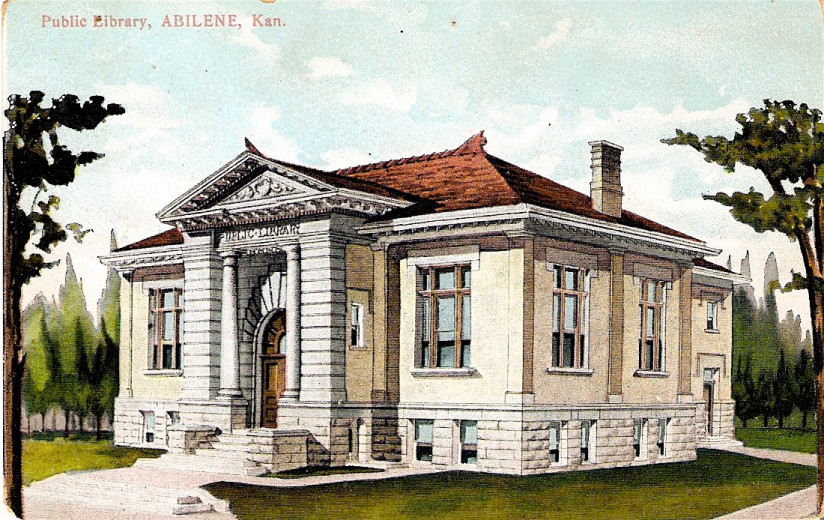Abilene Public Library / Carnegie Library
Statues grace the front lawn of the Abilene Public Library, including a special statue of Benjamin Franklin.
History
A Brief History of the Library
On December 20, 1900, the Ladies Literary Club of Abilene held a meeting at the home of Mrs. Thomas Kirby for the purpose of organizing a library association. Mrs. J.M. Gleissner was elected president of the new organization; Mrs. O.L. Moore was vice president; Mrs. H.L. Humphrey was treasurer, and Miss Mace King was secretary.
For the new Library Association, starting the library was a slow and tedious process. The first successful fundraising venture was a lecture by William Jennings Bryan, which earned the library 101 dollars. The ladies had other means of raising money, such as rummage sales, a Schumann concert, and selling Ms. Lillian Russel's fur coat. Mr. Parker, of carnival fame, donated funds for a day from a merry-go-round and a mystic maze for the library's benefit. With this money, the association was able to rent a room for 12 dollars per month on the second floor of the McInerney building (3rd and Broadway). Miss Lida Romig was employed as the first librarian. In 1903 the location of the library was changed to a room over what was the Kansas Power and Light office located at 200 N. Cedar.
In 1904, the women circulated a petition to vote on a tax levy of one mill to support the library. The question was favorably voted upon in the city election of 1905. Soon after this action, a board of trustees for the Abilene Public Library was formed. Mayor H.L. Humphrey wrote to Andrew Carnegie asking for a grant to erect a public library for Abilene.
There was great difficulty in securing a location after the Carnegie grant of $10,000 was obtained. At the time, the location decided upon was an eyesore to the whole town, covered with rubbish, an unsightly livery barn, four or five rickety buildings used for blacksmith shops and second-hand stores. The property was condemned for park purposes and, therefore, cleared to build the library. Andrew Carnegie agreed to increase his grant to $12,500 if the library board would agree to levy annually not less than 10 percent of his gift.
On October 1, 1908, the first building was presented to the public by Dr. F.S. Blayney, president of the library board; C.M. Harger accepted for the community. Many books were contributed by interested citizens, but no new books were purchased with tax money until 1913.
1934 Addition
As the library grew in acquisitions, Miss Romig and the board realized the building was too small, and they began to plan an addition to the North side. When the Public Works Administration came into being in 1930, the library obtained an allotment of $2,400 to add to the building fund, making a total of $10,081. In 1933, construction was begun on a stack room on the north side, with large additions to both the east and west wings of the original building. This was opened for public inspection on June 13, 1934.
During World II the library was an outstanding war information center.
Children's Library
The legacy of Thomas M. Jones in 1943 provided a children's library. The upstairs room had long been crowded, and in May of 1943, the children's books were removed from the east room upstairs to a new room downstairs. The children named the new room in the basement the Robert Louis Stevenson room.
1977 Addition
In 1974, plans were drawn for the addition of joining the Carnegie Library and the City building. The addition would house new facilities for the fire and police departments as well as an expansion for the library. In 1976, the library board gained approval for the library portion of the project. Work started in early 1977 and was open to the public on December 4, 1977. The total cost of the addition was $379,000.
Malott Room
On December 2, 1993, the Library featured the donated book collection of Dean W. Malott. Mr. Malott, born in Abilene in 1898, became the Chancellor of The University of Kansas and the president of Cornell University. Mr. Malott, who paid for the fine cabinets in the room, now known as the Malott room, had the room dedicated in memory of his father, M.H. Malott. Incidentally, the first memorial book donated to the library in 1929 was in memory of Mr. Malott's mother, Edith Gray Johnson Malott.
2009 Renovation
Citizens of Abilene voted 3 to 1 to fund the 1.6 million dollar library renovation project with a .35 percent sales tax increase. The city of Abilene also contributed $200,000 to the project, which began on November 11, 2008, and was completed on February 15, 2010. The Library moved to a temporary location at 1214 NW 3rd Street during this transition.
The renovated library now meets the regulations of the Americans with Disabilities Act. The entrance is now handicap accessible, as are the main-level restrooms. The library also underwent several other noticeable changes. Two Thousand square feet were added to the west side of the 1977 addition. The fourth level, with 2,800 square feet, was finished to house the reference and biography books, as well as the community living room. The Children's Library has expanded using the former Friends of the Library rooms. More space and new furniture have made it a cheerful and friendly environment. The Friends of the Library room has moved to the library's main level.
Mr. Carnegie wanted his money to be used for real and permanent good in this world. One can only assume that Mr. Carnegie would be very pleased that 102 years later, what is now known as the Carnegie-level of the library is used daily. The city commission room has been updated, as well as the Malott room. Periodicals are now housed on the Carnegie level, as is the microfilm reader in the genealogy room. A room formerly used as storage is now the Jordan Room, which is an ideal place for a group to hold a meeting or training. Tim Geske painted and restored the dome, making the Carnegie level breathtaking.
Andrew Carnegie also thought his institutions should create ladders on which the aspiring can rise. If one thinks about the many Abilene citizens who have frequented the library during the past 102 years, it can be assumed that the library certainly has served this purpose and will continue to do so.


